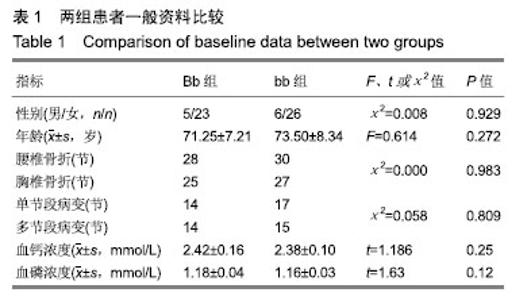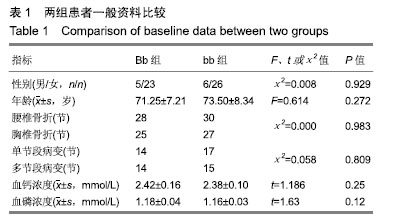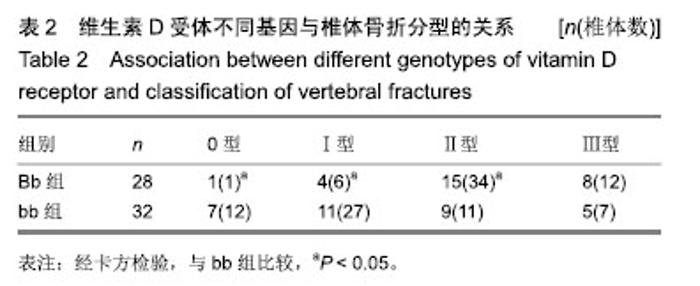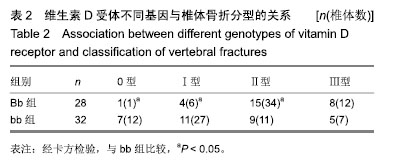| [1]Beaudart C, Biver E, Bruyère O, et al. Quality of life assessment in musculo-skeletal health. Aging Clin Exp Res.2018;30(5): 413-418.[2]Ballane G, Cauley JA, Luckey MM, et al. Worldwide prevalence and incidence of osteoporotic vertebral fractures.Osteoporos Int.2017;28(5):1531-1542. [3]梁玉柱,郭洪刚.老年骨质疏松性髋部骨折:昨天?今天及未来[J].中国组织工程研究,2017,21(15):2438-2443.[4]Yavropoulou MP, Kollia P, Chatzidimitriou D, et al. Severe osteoporosis with multiple spontaneous vertebral fractures in a young male carrying triple polymorphisms in the vitamin D receptor, collagen type 1, and low-density lipoprotein receptor-related peptide 5 genes.Hormones (Athens, Greece). 2016;15(4):551-556.[5]Wu J,Shang DP,Yang S,et al.Association between the vitamin D receptor gene polymorphism and osteoporosis.Biomedical Reports. 2016;5(2):233-236.[6]Wang YT,Tang SQ,Guo GB,et al. Analysis of lumbar bone mineral density in different age groups. Chinese MedicalHerald.2013; 10(22):134-135.[7]Genant HK,Wu CY,Kuijk CV, et al. Vertebral fracture assessment using a semiquantitative technique. J Bone Miner Res.1993; 8(9):1137-1148.[8]覃海飚,许建文,唐福波,等.骨质疏松性胸腰椎骨折伤椎骨造影弥散度与VDR基因多态性的关联性研究[J]. 微创医学,2016,11(6): 826-829.[9]Ismail AA, Cooper C, Felsenberg D, et al. Number and type of vertebral deformities: epidemiological characteristics and relation to back pain and height loss.Osteoporos Int.1999;9(3):206-213.[10]Heini PF.The current treatment-a survey of osteoporotic fracture treatment. Osteoporotie spine fractures: the spine surgeon′s perspective.Osteoporos Int.2005;16(Suppl 2): 85-92.[11]郝定均,贺宝荣,郭华,等.胸腰段骨质疏松性骨折严重程度评分评估及临床应用[J].中国脊柱脊髓杂志, 2013,23(8):730-733.[12]杨映雄,徐又佳,周爱建.老年男性原发性骨质疏松症的发生情况及其影响因素[J].广西医学,2018,40(1):7-9.[13]张奎,刘洋,马煜,王文己.骨质疏松性骨折与相关基因多态性研究进展[J].中国骨质疏松杂志,2017,23(7):974-980.[14]Lecka-Czernik B.Bone Loss in Diabetes: Use of Antidiabetic Thiazolidinediones and Secondary Osteoporosis.Curr Osteoporos Rep. 2010;8(4):178-184.[15]Just F, Reyer H, Muráni E, et al. Genetic variants of major genes contributing to phosphate and calcium homeostasis and their association with serum parameters in pigs.J Appl Genet. 2018; 59(3):325-333. [16]张新,王晓慧,何泳,等.VDR基因多态性与维持性血液透析患者肾性骨营养不良的关系[J].临床肾脏病杂志,2018,18(11):682-686.[17]Lieben L, Masuyama R, Torrekens S, et al. Normocalcemia is maintained in mice under conditions of calcium malabsorption by vitamin D-induced inhibition of bone mineralization.J Clin Invest. 2012;122(5):1803-1815.[18]Yamamoto Y, Yoshizawa T, Fukuda T, et al. Vitamin D receptor in osteoblasts is anegative regulator of bone mass control. Endocrinology. 2013;154(3):1008-1020.[19]Takeda S, Yoshizawa T, Nagai Y, et al. Stimulation of osteoclast formation by 1,25-dihydroxyvitamin D requires its binding to vitamin D receptor (VDR) in osteoblastic cells: studies using VDR knockout mice. Endocrinology.1999;140(2):1005-1008.[20]Jawadi AH, Wakeel A, Tamimi W, et al. Association analysis between four vitamin D receptor gene polymorphisms and developmental dysplasia of the hip.J Genet.2018;97(4):925-930.[21]Gaffney-Stomberg E, Lutz LJ, Shcherbina A, et al. Association Between Single Gene Polymorphisms and Bone Biomarkers and Response to Calcium and Vitamin D Supplementation in Young Adults Undergoing Military Training.J Bone Miner Res. 2017; 32(3):498-507. [22]Marozik PM, Tamulaitiene M, Rudenka E,et al.Association of Vitamin D Receptor Gene Variation With Osteoporosis Risk in Belarusian and Lithuanian Postmenopausal Women.Front Endocrinol (Lausanne). 2018;9:305.[23]Zhang HH, Tao GS, Wu Q, et al. Studies on the frequencies of vitamin D receptorgene polymorphism in postmenopausalwomen lf Gan and Kazak nationality in China. J Bone Metab.2001;19(5): 321-323.[24]Kim JG, Kwon JH, Kim SH, et al.Association between vitamin dreceptor gene haplotypes and bone mass in postmenopausal Korean women. Am J Obstet Gynecol.2003;189(5): 1234-1240.[25]Kurabayashi T, Matsushita H, Kato N, et al. Effect of vitamin D receptor and estrogen receptor gene polymorphism on the relationship between dietary calcium and bone mineral density in Japanese women.J Bone Miner Metab. 2004;22(2):139-147. [26]李静静,司晓芸,毕晓红,等. 维生素D受体基因Bsm Ⅰ位点多态性对维持性血液透析患者骨代谢的影响[J]. 武汉大学学报(医学版),2015, 36(6):935-939.[27]Ling Y, Lin H, Aleteng Q, et al. Cdx-2 polymorphism in Vitamin D Receptor gene was associated with serum 25-hydroxyvitamin D levels, bone mineral density and fracture in middle-aged and elderly Chinese women.Mol Cell Endocrinol. 2016;427:155-161.[28]An M, Song XB. Vitamin D receptor BsmI polymorphism may be associated with an decreased osteoporosis risk in South China. Cell Mol Biol (Noisy-le-grand). 2017;63(5):50-54.[29]Shen H, Xie J.Vitamin D receptor gene and risk of fracture in postmenopausal women: a meta-analysis. Climacteric. 2014; 17(4):319-324.[30]邢丹,马信龙,马剑雄,等.维生素D受体基因Bsm I、Aoa I、Taq I、Fok I和Ccx-2位点多态性与骨质疏松性椎体骨折相关性的Meta分析[J]. 中国骨质疏松和骨矿盐疾病杂志, 2013,6(2):165-173.[31]董佑红,艾金伟,李德胜,等. 维生素D受体基因ApaⅠ、BsmⅠ、Tru9Ⅰ位点多态性与中国人群骨质疏松症关联性的Meta分析[J]. 湖北医药学院学报,2015,34(6):523-531,537. |



